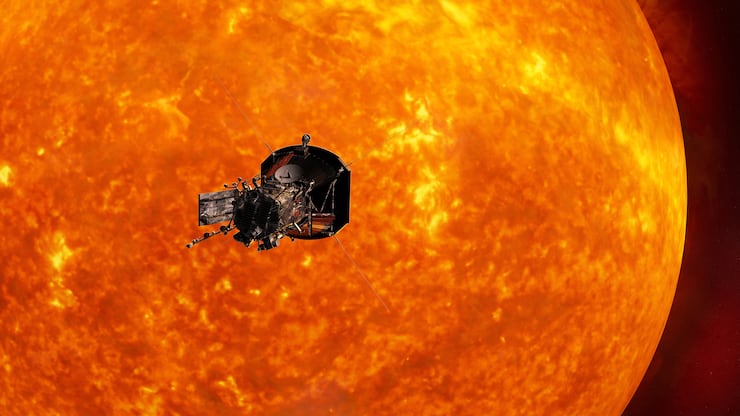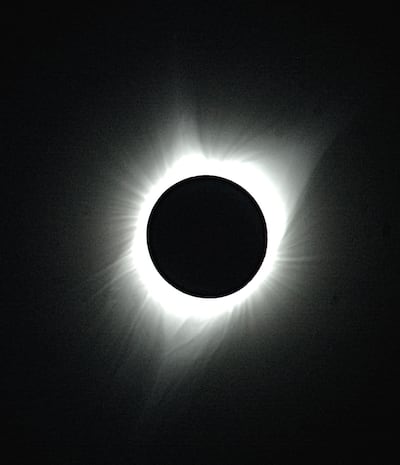Editor’s note: A version of this was previously published on the author’s website.
The more that scientists and engineers know about the nuclear reactor at the center of the solar system, the better they will be able to protect astronauts from its radiation, and the better for our understanding of stars in general.
With NASA’s goal of returning explorers to the moon by 2024 and going to Mars later, the need for this information is urgent. The Parker Solar Probe, an unusual armored spacecraft, has been swooping into the sun’s atmosphere to discover more about its dynamics.




As the first probe to transit through the sun’s searing corona, it is protected by a 4½-inch-thick heat shield constructed of carbon composite material plus a new “water-cooled solar array thermal management system.” It doesn’t fly through the hottest regions of the corona, but at times operates where the temperature reaches a blistering 2,500 degrees F. Despite the heat and radiation outside, most of the instruments remain at 85 degrees. “Only the electric field antennas and a small plasma detector will brave direct illumination from the sun,” NASA announced before it left Earth.
Named for pioneering solar researcher and theorist Eugene Newman Parker, who is 92 years old, the probe was launched on Aug. 12, 2018, from Cape Canaveral, Florida, aboard a Delta IV Heavy rocket with an upper stage. Over seven years, it is to loop near Venus seven times, using the planet’s gravity to move it closer to the sun. Eventually it will “fly through the sun’s atmosphere as close as 3.8 million miles to our star’s surface, well within the orbit of Mercury and more than seven times closer than any spacecraft has come before,” the space agency says.

Our yellow dwarf star is far from well understood. While its core burns at a ferocious 27 million degrees F, that’s not remarkable considering that the sun is a 4.5-billion-year-old nuclear furnace 864,000 miles across. (To put that size in perspective, the space agency adds, “If the sun were as tall as a typical front door, the Earth would be the size of a U.S. nickel.”) What is puzzling is that the corona, its envelope of gases, reaches 2 million degrees F, while the surface is 10,000 degrees. “How the sun manages this feat remains one of the greatest unanswered questions in astrophysics; scientists call it the coronal heating problem,” according to a July 2018 NASA release.
Spacecraft near Earth can measure aspects of the solar wind. But the Parker Solar Probe’s instruments are able to detect changes that occur in the corona long before they become buffered and dulled by mixing with other particles in the 93 million miles between the sun and Earth. “I’m almost certain we’ll discover new phenomena we don’t know anything about now, and that’s very exciting for us,” said deputy project scientist Nour Raouafi of Johns Hopkins University in Maryland, as quoted by NASA. “Parker Solar Probe will make history by helping us understand coronal heating — as well as solar wind acceleration and solar energetic particles — but I think it also has the potential to steer the direction of solar physics’ future.”
Toward those ends, the probe is measuring the sun’s plasma density and temperature, checking energetic atomic particles in relation to the solar wind and structures in the corona, and photographing the corona, the inner heliosphere (the vast realm of the sun’s charged particles), shock waves and other structures, according to the Johns Hopkins University Applied Physics Laboratory.
Radiation blasted from the sun by flares and coronal mass ejections can disrupt communications and potentially knock out power grids. That’s dangerous enough on Earth. But in space, beyond the planet’s protective atmosphere, solar energetic particles, SEPs, from some of these eruptions can damage satellites; worse, they could “pass right through (astronauts’) skin, shedding energy and fragmenting cells or DNA on their way. This damage can increase risk for cancer later in life, or in extreme cases, cause acute radiation sickness in the short-term,” according to a statement NASA issued on Aug. 7.
Flares and coronal mass ejections only rarely produce SEPs. Predicting when they will erupt might give astronauts time to get behind barricades in their craft and reduce exposure. By sailing into the region where SEPs originate, the Parker Space Probe may improve understanding of their formation and help scientists predict when they will occur.
In May, the probe completed its transmission of primary science data collected during the first two of it planned 24 solar passes, amounting to 22 gigabytes of data. This was 50% more information than scientists had expected by that point. Transmissions were so successful that the team is now receiving an additional 25 gigabytes, with the download expected to be finished during August.
Joe Bauman, a former Deseret News science reporter, writes an astronomy blog at the-nightly-news.com and is an avid amateur astronomer. His email is joe@the-nightly-news.com.






